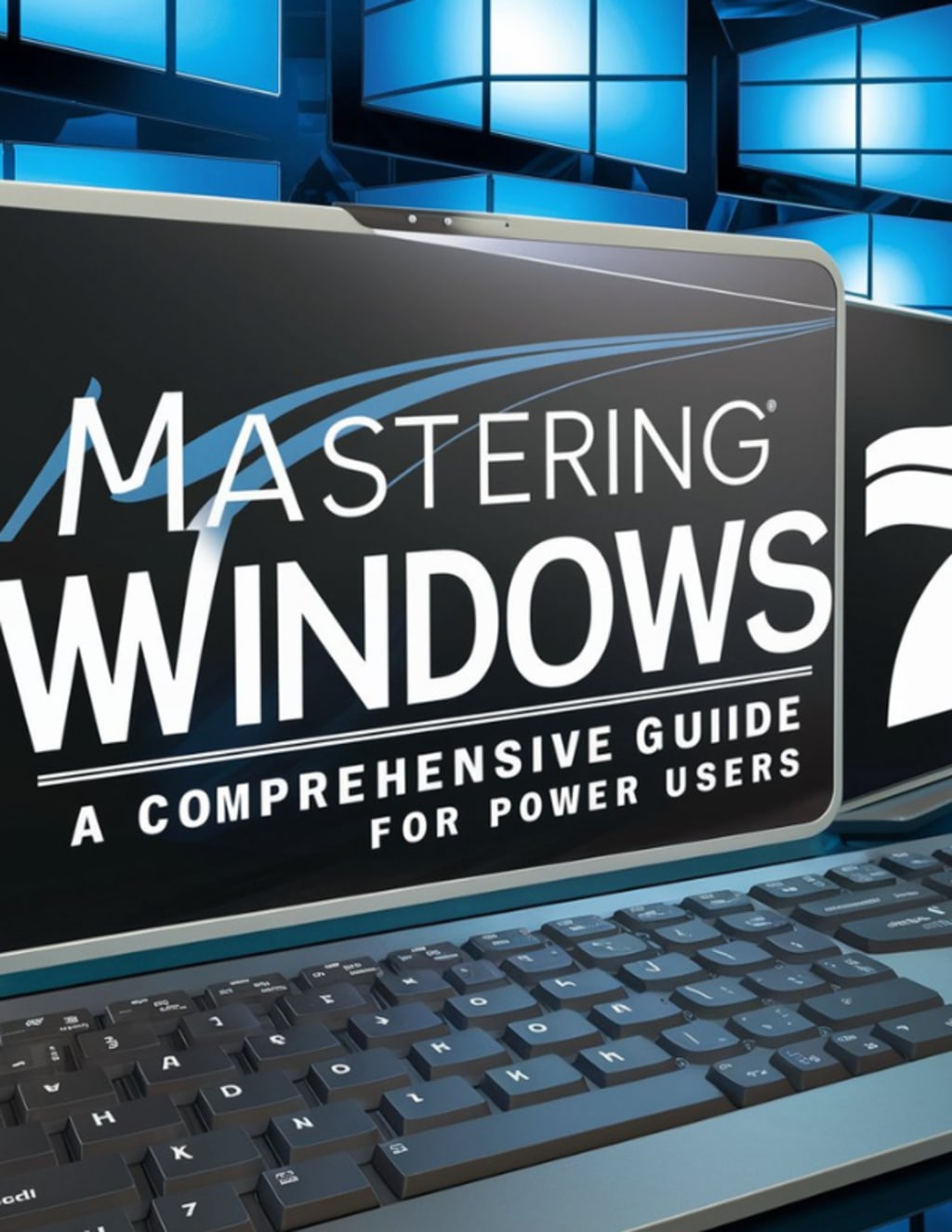
Introduction to Windows 7:
"Introduction to Windows 7" serves as the foundational chapter in our guide, setting the stage for understanding the key features and functionalities of this operating system. Windows 7, released by Microsoft in 2009, quickly became one of the most popular and widely used versions of Windows due to its user-friendly interface, stability, and performance improvements over its predecessor, Windows Vista.
This chapter begins by providing an overview of the Windows 7 operating system, highlighting its key attributes and improvements compared to earlier versions of Windows. It introduces users to the visual enhancements such as Aero Glass, the revamped taskbar (also known as the Superbar), and the redesigned Start menu, which all contribute to a more intuitive and streamlined user experience.
Furthermore, "Introduction to Windows 7" delves into the architecture and system requirements of the operating system, helping users understand what hardware specifications are necessary for optimal performance. It covers topics such as processor requirements, RAM, disk space, and graphics capabilities, ensuring that readers have a clear understanding of the hardware prerequisites for running Windows 7 smoothly.
Additionally, this chapter explores the various editions of Windows 7, including Home Premium, Professional, Ultimate, and Enterprise, outlining the differences between them and helping users choose the edition that best suits their needs and requirements.
Moreover, "Introduction to Windows 7" provides an overview of the installation process, guiding users through the steps required to install or upgrade to Windows 7 on their computers. It covers topics such as preparing for installation, choosing the installation type (upgrade or custom), partitioning disks, and configuring initial settings.
In summary, "Introduction to Windows 7" serves as a comprehensive primer for users who are new to the operating system or seeking to refresh their understanding. By familiarizing themselves with the core concepts and features of Windows 7, readers can lay a solid foundation for exploring more advanced topics covered in subsequent chapters of this guide.
"Getting Started with Windows 7" is a crucial chapter designed to help users become acquainted with the basic functionalities and navigation of the Windows 7 operating system. Whether you are a novice user or transitioning from an earlier version of Windows, this chapter serves as a fundamental guide to navigating your way around Windows 7.
The chapter begins with an introduction to the Windows 7 desktop, providing an overview of its primary elements such as the taskbar, desktop icons, Start menu, and system tray. Users will learn how to customize their desktop environment to suit their preferences, including changing wallpaper, rearranging icons, and adjusting screen resolution.
Next, "Getting Started with Windows 7" explores the Start menu in detail, demonstrating how to access programs, files, and system settings efficiently. Users will learn how to navigate the Start menu, search for programs and files, pin frequently used applications, and access system utilities and administrative tools.
Furthermore, the chapter covers basic navigation techniques within Windows Explorer, the file management tool in Windows 7. Users will learn how to navigate through folders, view file properties, copy, move, and delete files, and organize their files and folders effectively.
Additionally, "Getting Started with Windows 7" provides an overview of essential system settings and customization options, including setting up user accounts, configuring desktop themes, adjusting system sounds, and managing system updates.
Throughout the chapter, users will find step-by-step instructions accompanied by screenshots and illustrations, making it easy to follow along and implement the concepts discussed.
In summary, "Getting Started with Windows 7" serves as a comprehensive introductory guide that equips users with the necessary knowledge and skills to navigate and customize the Windows 7 operating system efficiently. By mastering the basics covered in this chapter, users will be well-prepared to explore more advanced features and functionalities offered by Windows 7.
"Customizing Your Desktop and Taskbar" is a pivotal chapter in our guide, empowering users to personalize their Windows 7 experience to suit their preferences and workflow. This chapter delves into the myriad of customization options available for the desktop and taskbar, enabling users to tailor their computing environment to reflect their unique style and enhance productivity.
The chapter begins by exploring desktop customization options, including changing wallpaper, screensavers, and desktop icons. Users will learn how to select from a variety of pre-installed wallpapers or use their own images to personalize their desktop background. Additionally, the chapter covers how to adjust screen resolution and desktop icon size to optimize visual clarity and organization.
Next, "Customizing Your Desktop and Taskbar" delves into the customization of the taskbar, one of the most prominent features of the Windows 7 interface. Users will learn how to resize and reposition the taskbar, as well as customize its appearance by enabling or disabling features such as Aero Peek, Aero Shake, and taskbar thumbnails.
Furthermore, the chapter explores taskbar pinning, a feature that allows users to pin frequently used programs and files to the taskbar for quick access. Users will learn how to pin and unpin items from the taskbar, organize pinned items into logical groups, and utilize jump lists to access recent documents and perform common tasks.
Additionally, "Customizing Your Desktop and Taskbar" covers advanced taskbar customization options, such as creating custom toolbars, enabling or disabling system icons and notifications, and configuring taskbar properties to suit individual preferences.
Throughout the chapter, users will find practical tips, tricks, and step-by-step instructions accompanied by screenshots and illustrations, ensuring clarity and ease of implementation.
In summary, "Customizing Your Desktop and Taskbar" empowers users to transform their Windows 7 desktop and taskbar into a personalized and efficient workspace. By mastering the customization options covered in this chapter, users can optimize their computing environment to enhance productivity and streamline workflow according to their unique needs and preferences.
"Managing Files and Folders Efficiently" is a vital chapter in our guide, focusing on essential techniques and strategies to organize, navigate, and manipulate files and folders within the Windows 7 operating system. Efficient file and folder management are critical skills for users to maintain a well-organized digital workspace, streamline workflow, and locate information quickly.
The chapter begins by introducing users to Windows Explorer, the primary file management tool in Windows 7. Users will learn how to navigate through folders and directories, view file and folder properties, and customize folder views to suit their preferences.
Next, "Managing Files and Folders Efficiently" explores techniques for organizing files and folders effectively. Users will discover how to create new folders, rename files and folders, and move or copy files between folders. Additionally, the chapter covers advanced file management tasks such as grouping files by type, sorting files by various criteria, and using libraries to aggregate related files from multiple locations.
Furthermore, the chapter delves into file manipulation techniques, including selecting multiple files, using keyboard shortcuts for common file operations, and performing batch operations to save time and effort.
Moreover, "Managing Files and Folders Efficiently" addresses file searching and filtering techniques to help users locate specific files or folders quickly. Users will learn how to use the built-in search functionality in Windows Explorer, apply search filters to narrow down search results, and save search queries for future use.
Additionally, the chapter covers file and folder security measures, including setting permissions and access rights to protect sensitive data from unauthorized access.
Throughout the chapter, users will find practical tips, best practices, and step-by-step instructions accompanied by screenshots and illustrations, ensuring clarity and ease of implementation.
In summary, "Managing Files and Folders Efficiently" equips users with the necessary skills and techniques to maintain a well-organized digital workspace within the Windows 7 environment. By mastering the file management strategies covered in this chapter, users can enhance productivity, reduce clutter, and optimize their workflow for greater efficiency and effectiveness.
"Mastering Windows Explorer" is a pivotal chapter in our guide, focusing on empowering users with comprehensive knowledge and advanced techniques for efficient file and folder management within the Windows 7 operating system. Windows Explorer serves as the primary interface for navigating and managing files and folders, making it essential for users to master its functionalities to streamline their workflow and optimize productivity.
The chapter begins by providing an in-depth overview of Windows Explorer, introducing users to its various components and features. Users will learn how to access Windows Explorer, navigate through folders and directories, and customize the interface to suit their preferences.
Next, "Mastering Windows Explorer" delves into advanced navigation techniques, including breadcrumb navigation, address bar navigation, and using keyboard shortcuts for efficient navigation. Users will discover how to quickly navigate to specific folders, switch between different views, and customize folder options to enhance navigation efficiency.
Furthermore, the chapter explores file and folder management techniques within Windows Explorer. Users will learn how to create new folders, rename files and folders, move or copy files between folders, and delete files securely. Additionally, the chapter covers advanced file management tasks such as selecting multiple files, grouping files by type, and sorting files by various criteria.
Moreover, "Mastering Windows Explorer" addresses advanced search and filtering techniques to help users locate specific files or folders quickly. Users will learn how to use the built-in search functionality in Windows Explorer, apply search filters to narrow down search results, and save search queries for future use.
Additionally, the chapter covers file manipulation techniques, including batch operations, file compression, and using libraries to aggregate related files from multiple locations.
Throughout the chapter, users will find practical tips, best practices, and step-by-step instructions accompanied by screenshots and illustrations, ensuring clarity and ease of implementation.
In summary, "Mastering Windows Explorer" equips users with the advanced skills and techniques necessary to leverage the full potential of Windows Explorer for efficient file and folder management within the Windows 7 environment. By mastering the functionalities covered in this chapter, users can enhance productivity, streamline workflow, and optimize their digital workspace for greater efficiency and effectiveness.






Comments
There are no comments for this story
Be the first to respond and start the conversation.